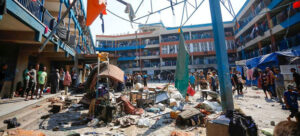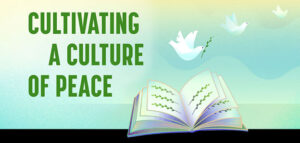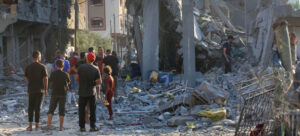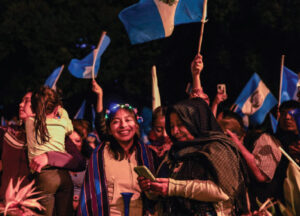
Armed Conflicts, Civil Society, Global Governance, Headlines, Human Rights, Middle East & North Africa, TerraViva United Nations

Credit: UNRWA
– Today’s weapons are capable of wiping out entire swaths of humanity, demolishing remaining shreds of culture along with them. News coverage of the one-sided Gaza campaign make it plain that’s exactly what’s happening. Destroying the past destroys the future too. The world must band together to make sure these atrocities stop.
Israel’s war crimes against Palestinian civilians in Gaza have now reached a new low, despite continuing international protests and UNESCO complaints over the destruction of culture. After nearly a year of overkill, Israeli jets continue to drop bombs on hospitals, schools, and refugees in flimsy tent camps, killing increasing numbers of people who never had anything to do with starting the war.
Four months ago on May 15, Israeli’s Minister of Defense, Yoav Gallant, reported to Prime Minister Netanyahu that “HAMAS no longer functions as a military organization.” Lately it has been clear to everybody that there are no more military objectives left in Gaza.
It can only mean that the incessant bombing of the last four months, killing scores of innocent people every week, were intended to punish Gaza by intentionally killing civilians. Despite the claim that those being bombed are terrorists, there is no evidence to support that claim. It’s an outrage. War crimes keep piling up.
Just last week, on September 10 2024, after nearly a year of incredibly destructive bombing, Israeli jets struck the flimsy tents in al-Mawasi Camp, formerly declared a safe zone by the IDF itself, killing dozens of people and leaving three craters 30 feet deep.
A day later, the UN school in Jabalia Camp used as a shelter was bombed for the umpteenth time, killing at least 18, including 6 UN/UNRWA staff members, with local people claiming up to 60 deaths. After so many months and so many innocent people killed, what could possibly account for this continuing barbarity?
Deliberately targeting civilians anywhere is illegal under international law, and especially in declared safe zones within United Nations shelters and tent camps. Such overkill is incomprehensible to most of the civilized world, but also to nearly a million Israelis who regularly protest their government’s unwillingness to accept a cease-fire.
They have been in the streets for months begging the Likud-dominated War Cabinet to stop the war and free the diminishing number of Israeli captives. Weak cautions from the US White House have had no effect.
It is difficult to see how any of this benefits Israel. Their actions have raised worldwide scorn for the government in Jerusalem that insists on continuing the war. They have only succeeded in empowering the BDS (Boycott, Divestment, and Sanctions) movement.
How can continued bombing reach any rational objective except to incite Israel’s enemies with more hatred and revenge killing extending far into the future? A military doctrine of “maximum force” can only mean killing large numbers of non-combatant women and children. These one-sided attacks will soon reach the one-year mark.
The only possible reasons for continuing Israel’s eleven-month killing spree in Gaza—since Netanyahu recently blocked a cease fire with HAMAS that might have rescued the hostages—is to decimate Palestine’s future along with its past, an important goal for the government in Jerusalem.
Targeting Palestine’s youth by bombing schools inevitably destroys their future opportunities along with the historical memory of the Palestinian people’s collective nationhood. Young people will be unable either to get jobs or reclaim their rightful heritage.
This barbaric one-sided atrocity in Gaza continues despite President Joe Biden and Democratic Candidate Kamala Harris’ words supporting two states. That formulation is now an improbable dream—far off if it ever happens. Most analysts believe it’s undo-able at this point, after hundreds of thousands of settlers have moved into the West Bank.
Humanity—meaning all of us—continues to struggle today amid an atmosphere of fear and lust for power. Bloody Gaza is at the center of a growing vortex in today’s sea of troubles.
James E. Jennings, PhD is President of Conscience International www.conscienceinternational.org and Executive Director of US Academics for Peace. Jennings has delivered humanitarian aid to Gaza’s hospitals since 1987, including during the first intifada, the al-Aqsa intifada, and Israel’s “Cast Lead” bombing attacks in 2009 and 2014.
IPS UN Bureau












